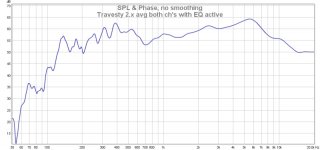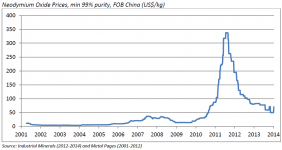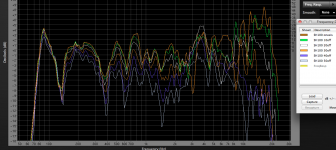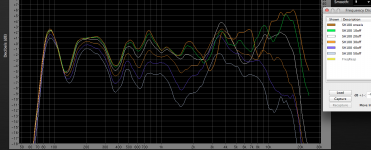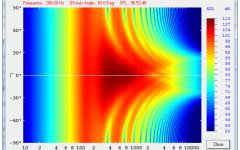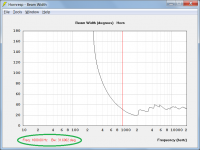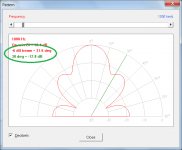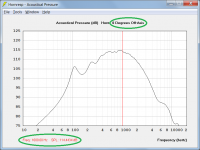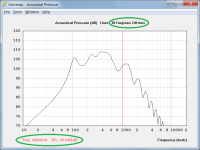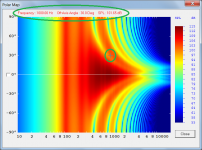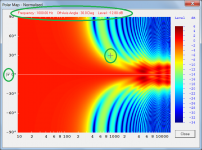Thinking it over...So many options!
[This is sort of musing over the options for the HF/Mid of a Unity or synergy...]
Compression Driver vs. Cone: seems to be 50/50 for DIY bulds; a CD is more efficient but they tend to be attenuated to match the MF. Also more expensive. Another problem is that a CD "adds" more distance to the critical 1/4 wave distance between HF and MF ports. Cone driver (e.g. Typmhany TC9) advantages: inexpensive. More to choose from (?); major plus is that it is easy to find one to cross over ~ 1000 Hz, compared to many CD. For home hi-fi use, the major dB output of a CD may not be needed.
Preponderance of the evidence: favor a cone tweeter for HF.
Mids: most DIY say to use small mids, even full range or woofers. Open or closed back? Hard NOT to find one that will play up to 1000 Hz or so. Nevertheless, only certain mids are suitable for effectively being a compression driver through a port.
Unexplored: use of a very wide range (e.g. coaxial) CD such as a BMSxxxx for the HF + MF driver. The BMS drivers seem to be very highly rated and Danley uses them. Is this the lazy man's (me!) way to cheat and make a decent Unity | Synergy ? If one goes the coax route, is one required to use the crossover of BMS or can one still use DSP? Phase coherence/point source is claimed to be excellent; but does the coax design prevent the user from experimenting with different x-over etc.?
[This is sort of musing over the options for the HF/Mid of a Unity or synergy...]
Compression Driver vs. Cone: seems to be 50/50 for DIY bulds; a CD is more efficient but they tend to be attenuated to match the MF. Also more expensive. Another problem is that a CD "adds" more distance to the critical 1/4 wave distance between HF and MF ports. Cone driver (e.g. Typmhany TC9) advantages: inexpensive. More to choose from (?); major plus is that it is easy to find one to cross over ~ 1000 Hz, compared to many CD. For home hi-fi use, the major dB output of a CD may not be needed.
Preponderance of the evidence: favor a cone tweeter for HF.
Mids: most DIY say to use small mids, even full range or woofers. Open or closed back? Hard NOT to find one that will play up to 1000 Hz or so. Nevertheless, only certain mids are suitable for effectively being a compression driver through a port.
Unexplored: use of a very wide range (e.g. coaxial) CD such as a BMSxxxx for the HF + MF driver. The BMS drivers seem to be very highly rated and Danley uses them. Is this the lazy man's (me!) way to cheat and make a decent Unity | Synergy ? If one goes the coax route, is one required to use the crossover of BMS or can one still use DSP? Phase coherence/point source is claimed to be excellent; but does the coax design prevent the user from experimenting with different x-over etc.?
With 459* there are not muchbut does the coax design prevent the user from experimenting with different x-over etc.?
1) Closed back mid drivers generally don't go very low, so are a more limited bandwidth choice than "full range" drivers or woofers.1)Mids: most DIY say to use small mids, even full range or woofers. Open or closed back?
2)Unexplored: use of a very wide range (e.g. coaxial) CD such as a BMSxxxx for the HF + MF driver. The BMS drivers seem to be very highly rated and Danley uses them. Is this the lazy man's (me!) way to cheat and make a decent Unity | Synergy ?
2)If one goes the coax route, is one required to use the crossover of BMS or can one still use DSP?
3)Phase coherence/point source is claimed to be excellent; but does the coax design prevent the user from experimenting with different x-over etc.?
2) DSL uses the dual voice coil BMS compression drivers at 1500 Hz and above in some of the very high SPL units, using cone drivers below. The dual voice coil BMS drivers for home use could go as low as 300 Hz or so, but an inexpensive cone driver would outperform them in the lower octave, and go low enough to not require another driver from 300 to 100 Hz. Using DSP for the dual voice coil crossover works fine, but requires another amp channel.
DSL uses a 5"cone/1" compression driver coax in the SM-60F (with 2x8" below), that type of co-ax would be more appropriate for home use.
3)DSP is preferable (other than the cost) as a small delay is actually needed for optimal phase and frequency response with the dual voice coil drivers.
Implementation of any driver on a constant directivity horn (as in any Synergy design) requires a HF compensation curve (a HF boost of 6-15 dB above 3kHz or so), far easier to implement with DSP than using passive components.
Flaesh, what is "459*" 
I did an actual measurement! DB level is not calibrated but the FR looks not so bad. I seem to get down to around 140 Hz near Listening Position.
THD (not shown) is around 7% in left, and well < 1 % in Right. Perhaps due to dodgy mids drivers ?
These are probably my "final" Travesty 2.x; I have exhausted my supply of "CTS-clone" for mids and I've added batts of insulation and rear panels to each speaker. I need to hook up my better (not the coroplast experiment) sub so I will hear some bass again.
While I've yet to do so, the best I can do to calibrate my ECM3000 is to set the level on the DEQ2496 and then do sweeps via the AudioBox. I may push the drivers to self-destruction when I see what levels I can get out of them
I'm sure another "Travesty" build in the near future with better drivers. My supply of signs is still abundant so it looks like Lowe's Depot won't be selling me any lumber any time soon
I did an actual measurement! DB level is not calibrated but the FR looks not so bad. I seem to get down to around 140 Hz near Listening Position.
THD (not shown) is around 7% in left, and well < 1 % in Right. Perhaps due to dodgy mids drivers ?
These are probably my "final" Travesty 2.x; I have exhausted my supply of "CTS-clone" for mids and I've added batts of insulation and rear panels to each speaker. I need to hook up my better (not the coroplast experiment) sub so I will hear some bass again.
While I've yet to do so, the best I can do to calibrate my ECM3000 is to set the level on the DEQ2496 and then do sweeps via the AudioBox. I may push the drivers to self-destruction when I see what levels I can get out of them

I'm sure another "Travesty" build in the near future with better drivers. My supply of signs is still abundant so it looks like Lowe's Depot won't be selling me any lumber any time soon
Attachments
Ijit fidgeting...
"And you may ask yourself
Am I right?...Am I wrong?
And you may tell yourself
MY GOD!...WHAT HAVE I DONE?"
-- Talking Heads, "Once in a Lifetime"
So many options...The idea of a compression driver excites me (never done that before) but how do you screw a driver onto a piece of coroplast
While my morning sweep was far from authoritative, 24" square mouth gives a cutoff of about 160 Hz, within sight (sound?) of Schroeder and subwoofer land. So, repeating myself again I need to take some dB measurements to determine how loud I dare to blare
I need to take some dB measurements to determine how loud I dare to blare 
Then start shopping for louder stuff....
"And you may ask yourself
Am I right?...Am I wrong?
And you may tell yourself
MY GOD!...WHAT HAVE I DONE?"
-- Talking Heads, "Once in a Lifetime"
So many options...The idea of a compression driver excites me (never done that before) but how do you screw a driver onto a piece of coroplast
While my morning sweep was far from authoritative, 24" square mouth gives a cutoff of about 160 Hz, within sight (sound?) of Schroeder and subwoofer land. So, repeating myself again

Then start shopping for louder stuff....
Ijit discovers the affordable (?) Danley SM100
Has the consumer Danley finally arrived?
I'm looking at the web site and see that there is a “Molded Synergy Horn” line now.
The SM-100 would seem like a good basic hi-fi speaker. I'm afraid to know the price
I see it's been mentioned a few times here at DIYAudio, but I've found no build plans yet.
Based on Danley's known association with German manufacturer BMS and my investigative skills, since the DSL site describes the driver as an 8” coax, here are the likely suspects:
8CN522, neodymium, 8” similar FR, similar (lowever) power handling for “raw” driver. (Assitance Audio, $ 355.00 /each);
8C250, ferrite, 8” , very similar, I don't see a diff between the two.
This is a “two-way Synergy” says DSL's page. Other spoil-sports (that means you peteleoni ) claim it is not a true Synergy. Very well. Hopefully at least the crossover is accessible so we can **** with it!
) claim it is not a true Synergy. Very well. Hopefully at least the crossover is accessible so we can **** with it!
Hmmm...12C362 (Assistance, audio, $346/each), will be a 12” at throat (?); all else being equal (it seldom is!) why not go for a bigger, uh, “mid” cone ???
Wildly optimistic, probably, but can I have my SM100 clone for (say) < $500/each, including materials (heaven forbid, even made out of plywood if coroplast fails me.)
All the above is relatively serious questioning, unlike the following attempt at humor.
DSL indicates the “molded Synergy” bins are “polyurea coated.” Now, since I am a DIY-er and always looking to save a dime, the following occurred to me. Urea is a chemical found in urine. “Poly” means “many”. Therefore, doesn't this mean I could do my own polyurea coating by, er, “making water” upon the completed cabinet several times? Or if you have many dogs in your neighborhood, you could place the cab next to a fire hydrant and let the local curs do the work for you
Has the consumer Danley finally arrived?
I'm looking at the web site and see that there is a “Molded Synergy Horn” line now.
The SM-100 would seem like a good basic hi-fi speaker. I'm afraid to know the price
I see it's been mentioned a few times here at DIYAudio, but I've found no build plans yet.
Based on Danley's known association with German manufacturer BMS and my investigative skills, since the DSL site describes the driver as an 8” coax, here are the likely suspects:
8CN522, neodymium, 8” similar FR, similar (lowever) power handling for “raw” driver. (Assitance Audio, $ 355.00 /each);
8C250, ferrite, 8” , very similar, I don't see a diff between the two.
This is a “two-way Synergy” says DSL's page. Other spoil-sports (that means you peteleoni
Hmmm...12C362 (Assistance, audio, $346/each), will be a 12” at throat (?); all else being equal (it seldom is!) why not go for a bigger, uh, “mid” cone ???
Wildly optimistic, probably, but can I have my SM100 clone for (say) < $500/each, including materials (heaven forbid, even made out of plywood if coroplast fails me.)
All the above is relatively serious questioning, unlike the following attempt at humor.
DSL indicates the “molded Synergy” bins are “polyurea coated.” Now, since I am a DIY-er and always looking to save a dime, the following occurred to me. Urea is a chemical found in urine. “Poly” means “many”. Therefore, doesn't this mean I could do my own polyurea coating by, er, “making water” upon the completed cabinet several times? Or if you have many dogs in your neighborhood, you could place the cab next to a fire hydrant and let the local curs do the work for you
Last edited:
The SM-100 frequency response is a bit on the rough side for "hi-fi", as of 2013 the pro net price was $1695.The SM-100 would seem like a good basic hi-fi speaker. I'm afraid to know the price
Hmmm...12C362 (Assistance, audio, $346/each), will be a 12” at throat (?); all else being equal (it seldom is!) why not go for a bigger, uh, “mid” cone ???
DSL also makes the SM80, a 12" 80 degree co-ax with a similar stubby round horn to the SM-100.
70 Hz- 20 kHz +/- 3dB is not "hi-fi"? Matter of opinion I guess...
Yeah, price a bit rich for me. But two coaxials in coroplast....hmmmm...... I'd still like to do a two-way (down to sub woofer frequencies)....I know this is a bit harder than a 3-way, but ... could use a CD for "tweeter" and then do the more traditional cone mids ... I know this is a, well, pattern flip from what I said a few posts earlier. An argument for a HF CD is to blast past the LPF a horn presents...
Yeah, price a bit rich for me. But two coaxials in coroplast....hmmmm...... I'd still like to do a two-way (down to sub woofer frequencies)....I know this is a bit harder than a 3-way, but ... could use a CD for "tweeter" and then do the more traditional cone mids ... I know this is a, well, pattern flip from what I said a few posts earlier. An argument for a HF CD is to blast past the LPF a horn presents...
The second mouse gets the cheese...
[As a service to foreigners, a brief explanation of the above title] In English (American?) we have a saying for wisdom of being punctual, "The early bird gets the worm." Some cheeky fellow invented the revision above
In any case, I apologize for being "late to the party," as usual. I'm still reading up on Danley and DIY horns. While my current fixation is BMS drivers, I see they have been in use including for DIY, at least since 2011. Please forgive me for being so far behind the times.
I'm trying to get more current. For example, I see that Ben Carson has dropped out of the race. Just as well, I don't think America is ready for a Black president
Another advantage of being a few years late. I had to look up the "neodymium crisis" [ca. 2011]. I am aware that Neo is used for magents in primo drivers. Based on this chart, Neodymium (and many other commodities, e.g. Gold) had a speculative boom and bust, just like happens in many markets every few to ten years... while I've not researched it, nor do I care to, Neodymium is probably at more reasonable prices lately, it follows that (say) BMS drivers are a better deal now too. Are BMS compression drivers a long-term investment, then? Maybe, but I'd recommend you stick to Kruggerands or American Eagles, Maple Leafs, etc.
[As a service to foreigners, a brief explanation of the above title] In English (American?) we have a saying for wisdom of being punctual, "The early bird gets the worm." Some cheeky fellow invented the revision above
In any case, I apologize for being "late to the party," as usual. I'm still reading up on Danley and DIY horns. While my current fixation is BMS drivers, I see they have been in use including for DIY, at least since 2011. Please forgive me for being so far behind the times.
I'm trying to get more current. For example, I see that Ben Carson has dropped out of the race. Just as well, I don't think America is ready for a Black president
Another advantage of being a few years late. I had to look up the "neodymium crisis" [ca. 2011]. I am aware that Neo is used for magents in primo drivers. Based on this chart, Neodymium (and many other commodities, e.g. Gold) had a speculative boom and bust, just like happens in many markets every few to ten years... while I've not researched it, nor do I care to, Neodymium is probably at more reasonable prices lately, it follows that (say) BMS drivers are a better deal now too. Are BMS compression drivers a long-term investment, then? Maybe, but I'd recommend you stick to Kruggerands or American Eagles, Maple Leafs, etc.
Attachments
Last edited:
Also a matter of the smoothing applied to the frequency response curves.70 Hz- 20 kHz +/- 3dB is not "hi-fi"? Matter of opinion I guess...
No smoothing, the SH-100 is around +/- 8 dB, with as much smoothing as Smaart allows, +/- 5 dB, as the outdoor measurements below show.
The frequency response could be equalized nicely up to around 2kHz, but the coaxial 8"/1" polar response above that point is irregular, so equalization can only correct response at one listening angle.
This compromised polar response is typical of coaxial speakers that use the woofer cone as an extension of the HF horn. The same HF driver on a proper horn can have excellent HF polar response, and much smoother frequency response.
Attachments
4590, 4592, 4593, 4594, 4595 coax drivers.Flaesh, what is "459*"
Mid falls above and tweeter below 6*** Hz.
Good points. I've read today, too, that a problem of [all?] coaxials is that the tweeter can be modulated by the woofer, creating some type of distortion.
[Jackass mode On]
With April Fool's Day just weeks away, I had a silly idea that audio snobs might pull on their friends. The unsavory part of this is you must buy (perhaps borrow?) a pair of Bose 901's. The original (series I, II) will be simplest. Perhaps you can have them sneaked into your home at night, during a moonless foggy night. Anyway, the trick is as follows:
Carefully remove, or just disconnect, the nine stock drivers. Replace the single "front" driver with a high-quality full range, coaxial, etc. that will fit. Enlarge the hole if you can. Seal it up, wire it, put on grills, etc,. Assuming an approximately correct box volume, you now have a good to excellent quality full range speaker disguised as the loathsome 901
If your friends don't faint upon seeing them on those gleaming chrome stands in your listening room, they will faint (or 'soil themselves' ) when they hear decent sounding music come from those 1970s walnut veneer abominations
) when they hear decent sounding music come from those 1970s walnut veneer abominations  Enjoy!
Enjoy!
[Jackass Mode = OFF ]
[Jackass mode On]
With April Fool's Day just weeks away, I had a silly idea that audio snobs might pull on their friends. The unsavory part of this is you must buy (perhaps borrow?) a pair of Bose 901's. The original (series I, II) will be simplest. Perhaps you can have them sneaked into your home at night, during a moonless foggy night. Anyway, the trick is as follows:
Carefully remove, or just disconnect, the nine stock drivers. Replace the single "front" driver with a high-quality full range, coaxial, etc. that will fit. Enlarge the hole if you can. Seal it up, wire it, put on grills, etc,. Assuming an approximately correct box volume, you now have a good to excellent quality full range speaker disguised as the loathsome 901
If your friends don't faint upon seeing them on those gleaming chrome stands in your listening room, they will faint (or 'soil themselves'
[Jackass Mode = OFF ]
That would be true for co-ax designs using the speaker cone as an extension of the HF horn. Many co-ax designs use a separate HF horn in front of the cone, eliminating the frequency and IM distortion problems, but introducing diffraction problems.Good points. I've read today, too, that a problem of [all?] coaxials is that the tweeter can be modulated by the woofer, creating some type of distortion.
What specifically does this plot mean?
I'm sure this is an example of a horrible polar response, but I am not sure quite how to read the polar. This is a hornresp plot of one of my straight conical horns (all I am trying lately). Perhaps I should learn one of the other simulators, but since so far I am building with coroplast and gorilla glue, it's probably just faster to build a prototype. I should be thankful, no doubt, that I don't have the equipment, or at least, not the knowledge on how to do a polar response plot of a real speaker.
I'm leaning towards ordering a pair of BMS 8CN522; this is my guess of the "guts" of the SM-100 and since the rest of it is just plastic, I can figure that part out and improvise with coroplast and adhesives. How hard can it be ?
More serious: if I'm careful, I don't see why I could not re-use the drivers in other builds, or even (Heaven forbid!) a normal box. They are supposed to be very good drivers.
I'm sure this is an example of a horrible polar response, but I am not sure quite how to read the polar. This is a hornresp plot of one of my straight conical horns (all I am trying lately). Perhaps I should learn one of the other simulators, but since so far I am building with coroplast and gorilla glue, it's probably just faster to build a prototype. I should be thankful, no doubt, that I don't have the equipment, or at least, not the knowledge on how to do a polar response plot of a real speaker.
I'm leaning towards ordering a pair of BMS 8CN522; this is my guess of the "guts" of the SM-100 and since the rest of it is just plastic, I can figure that part out and improvise with coroplast and adhesives. How hard can it be ?
More serious: if I'm careful, I don't see why I could not re-use the drivers in other builds, or even (Heaven forbid!) a normal box. They are supposed to be very good drivers.
Attachments
Last edited:
I'm sure this is an example of a horrible polar response, but I am not sure quite how to read the polar.
The Hornresp polar map is a three-dimensional chart - the third dimension is colour. It enables different aspects of directivity performance to be consolidated onto the one chart, as illustrated in the following example.
Attachment 1 shows that at a frequency of 1000 Hz, the sound pressure level 30 degrees off-axis is 101.65 dB.
Attachment 2 shows the pressure response 30 degrees off-axis. At 1000 Hz the SPL is 101.6456 dB, the same as that given by the polar map (rounded to two decimal places).
Attachment 3 shows the on-axis pressure response. At 1000 Hz the SPL is 114.4434 dB.
Attachment 4 shows the directivity pattern at 1000 Hz. The -6dB beam width is 31.6 degrees, and 30 degrees off-axis the SPL is 12.8 dB less that the on-axis pressure. The 30 degree off-axis SPL given in Attachment 2 is 101.6456 dB and the on-axis SPL given in Attachment 3 is 114.4434 dB. The difference between the two is 12.8 dB, the same as the value given above.
Attachment 5 shows the -6dB beam width response. At 1000 Hz the beam width is 31.6002 degrees, the same as given on the directivity pattern (rounded to 1 decimal place).
Attachment 6 shows the polar map pressure levels normalised to the on-axis values. At 1000 Hz and 30 degrees-off-axis the response is 12.80 dB down, the same as given in Attachment 4.
Directivity can be expressed a number of different ways. The polar map effectively brings the key indicators together on a single chart.
Attachments
nc535: I will check the other drivers you recommend. Thank you. Cost is a consideration, but I have more money than DIY skills. Just not enough to buy a new pair of Danleys  If I get the BMC coax pair, I rationalize such purchases as "I can re-sell them and get some of the money back." Usually this is the case. Let's face it, a lot of people here can build a wood speaker, even something exotic like a Unity or Synergy clone, because they have a fully equipped wood shop or even a CNC machine available, as well as years of experience. Then there are duffers like me who have the cheapest electric jig saw and drill that Lowe's Depot sells
If I get the BMC coax pair, I rationalize such purchases as "I can re-sell them and get some of the money back." Usually this is the case. Let's face it, a lot of people here can build a wood speaker, even something exotic like a Unity or Synergy clone, because they have a fully equipped wood shop or even a CNC machine available, as well as years of experience. Then there are duffers like me who have the cheapest electric jig saw and drill that Lowe's Depot sells 
Looking at it another way, I can sell my slightly used BMC 8CN552 much easier, and with no legal ramifications, than some wood shop wizard can sell his clone of a Synergy
David: thank you for the great clarification of the polar plot. Your software is great, thank you for sharing it with us DIY'ers both competent and (ahem...) otherwise
Looking at it another way, I can sell my slightly used BMC 8CN552 much easier, and with no legal ramifications, than some wood shop wizard can sell his clone of a Synergy
David: thank you for the great clarification of the polar plot. Your software is great, thank you for sharing it with us DIY'ers both competent and (ahem...) otherwise

- Status
- This old topic is closed. If you want to reopen this topic, contact a moderator using the "Report Post" button.
- Home
- Loudspeakers
- Multi-Way
- Help the Ijit write Ijit's guide to Danley tech
